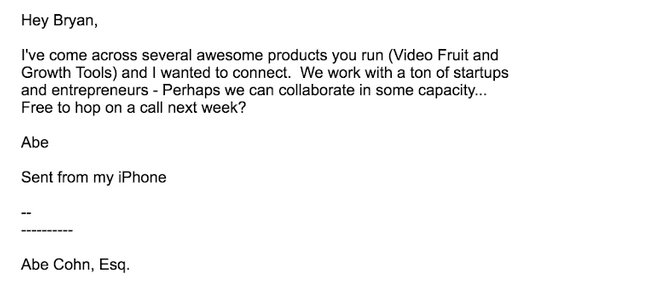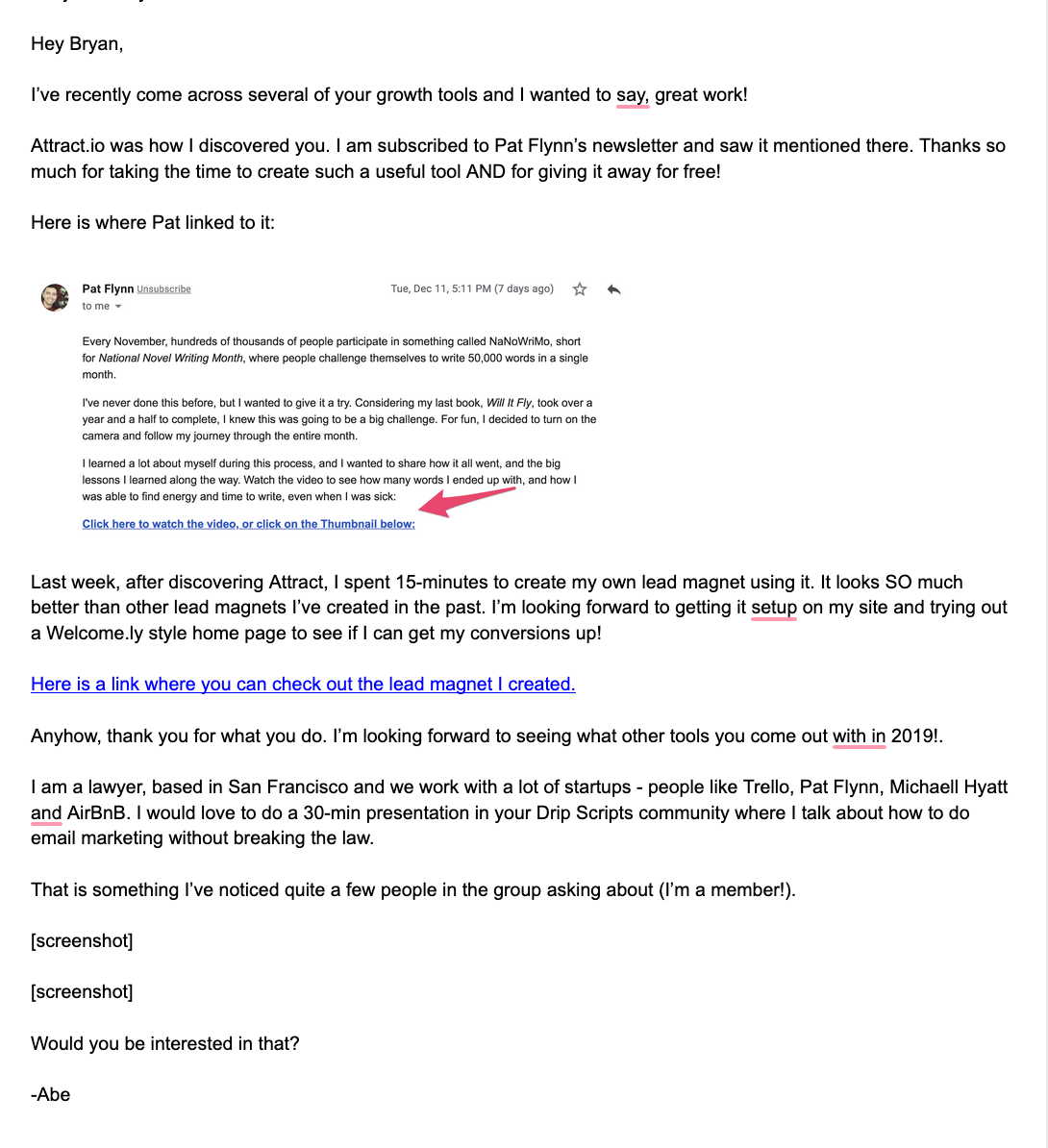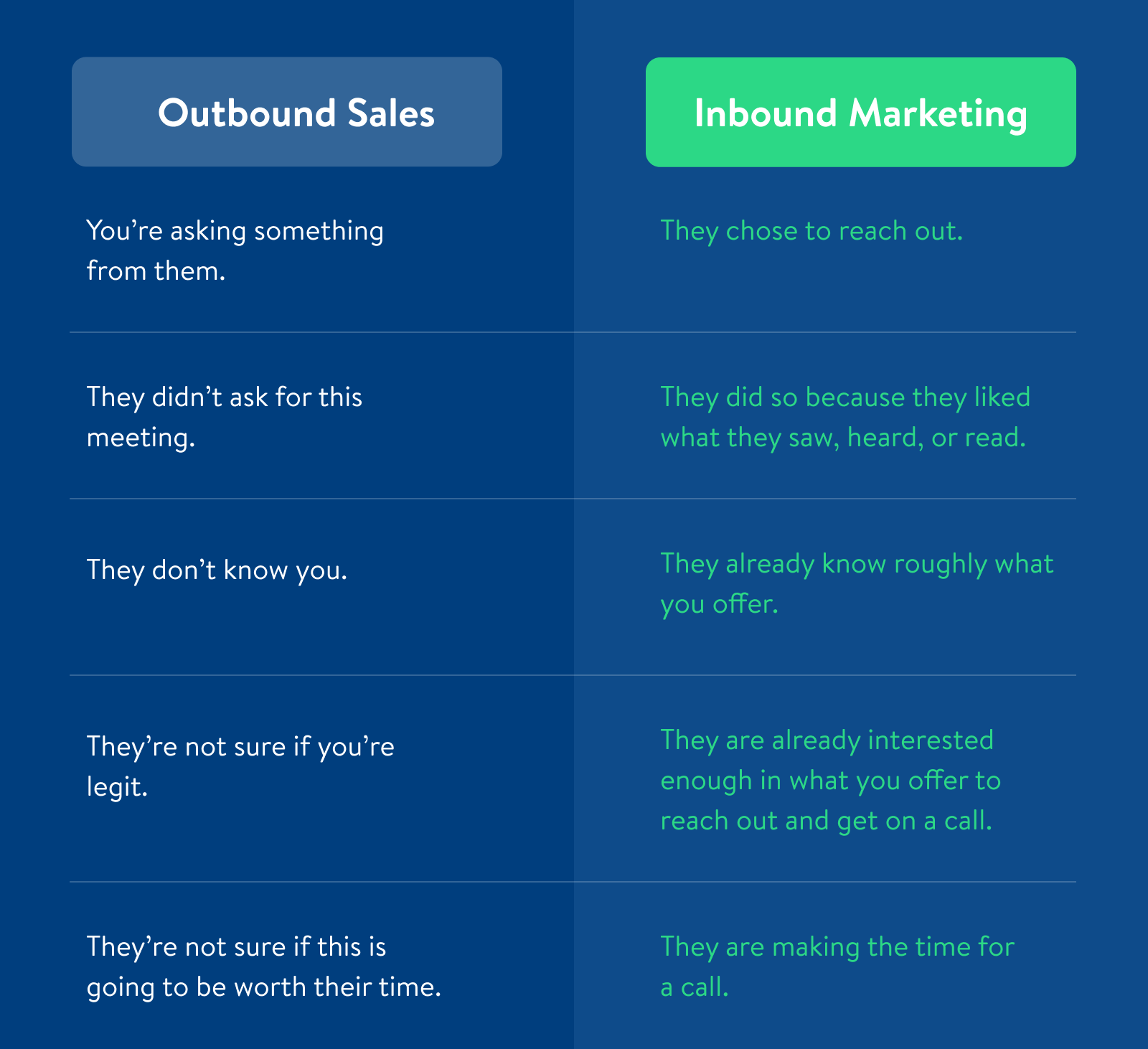How do most consultants get leads? They cold call.
They make a list of their top 100 prospects. They find their contact info. They send email after email. Make call after call. All to try to get a sales call booked.
Do most consultants like this? No!
But making a list of your target customers and reaching out cold has been the common sales advice for consultants since the beginning of time. It comes from the B2B world where cold emailing and cold calling are super common.
But let’s face it, cold calls suck.
It’s hard to close someone who has never heard of you and is likely not even thinking about needing your services right now.
But what if there was a way to market your own consulting business so that you never made another cold call again?
Where instead of you reaching out to prospects that aren’t expecting to hear from you, clients come to you who already know what you offer, already like your approach, and are already interested in potentially working with you.
It is possible and it’s something we used to grow our business to 7-figures (and still use); it’s something we’ve helped hundreds of consultants, coaches, and entrepreneurs use to get steady leads without cold calling.
We call it “partnerships” but before you jump to an idea of what that means, all it is is: Getting influential people or business owners in your industry that already have access to your target market to promote you to their audience.
The best part about it?
You don’t need a huge following or big company name. (Yes, really. More on this below.)
You don’t need to know the cool kids in your industry.
And it works for any industry, including consulting.
At Growth Tools, we’re living proof that this method works. When we started using partnership marketing to expand our own business, we increased sales by 48%.
In this article, we’re laying out a simple, four-step process for marketing consulting businesses with partnerships.
In short, it looks like this:
- Find where your prospective clients hang out online.
- Craft your unique angle.
- Pitch your potential partners.
- Close your leads.
By using this method, you can move away from sales-centered marketing tools. Follow these steps to a tee and you’ll feel more empowered to…
- Be more selective about who you work with.
- Charge higher rates.
- Never again have to cold pitch new clients.
But before we dive in, let’s take a moment to explain why this process will make you stand out in the first place.
Want help marketing your consulting business? You can book a complimentary strategy session where we’ll audit your business strategy and talk through a 90-day plan to skyrocket revenue.
Why Inbound Marketing Strategy Puts You in a Stronger Position with Consulting Clients Than Outbound Marketing
Like we said above, most consultants do outbound sales: make a list of prospects, bombard them with pitches (like cold calls or direct mail), and hope to get a sales meeting. Rinse. Repeat.
Stop and think about the relationship dynamic you are in with your lead if you use this approach:
- You’re asking something from them.
- They didn’t ask for this meeting.
- They don’t know you.
- They’re not sure if you’re legit.
- They’re not sure if this is going to be worth their time.
Good luck closing them!
Instead, think about the psychology of the inbound lead who already watched, listened to, or read something you made explaining your approach.
- They chose to reach out
- They did so because they liked what they saw, heard, or read
- They already know roughly what you offer
- They are already interested in what you offer enough to reach out and get on a call
Which of these scenarios will make for an easier sales call? Obviously the inbound approach. In fact, you almost don’t need a sales call in the traditional sense because you don’t need to pitch them on anything. They already know you, they already like you. You can use just a “Q&A call” which we explain below.
Inbound Marketing Gets You Out of the Feast or Famine Cycle
Outbound marketing, meanwhile, can feel like riding a roller coaster. Leads go up when you’re actively selling and prospecting. But leads go down the busier you become fulfilling them.

With inbound marketing, that ride is much more stable. For example, an online marketing tactic like a well-written blog post can generate traffic for years. When done right, inbound marketing tactics can create a steady and passive source of leads for your consulting business.
The Most Efficient Way to Do Inbound Marketing? Use Partnerships
Why?
Because you have instant credibility from your partners transferred to you.
Whether you’re a full-time management consultant, SEO consultant, or anything between, this is always the case. In our work with hundreds of clients, we’ve found it creates the highest rate of success.
Can this work for your specific industry? Yes.
Can this work if your business is in Australia, Italy, Japan, this place, or that place? Yes.
Everything we teach is basic human psychology. Getting eyeballs, building trust, and making buying easy for your target audience? Those are the fundamentals of marketing.
Partnerships just happen to be the most efficient way to do lead generation for new business.
Including consulting firms.
Here’s how to execute this marketing plan.
Step 1: Find Out Where Your Clients Hang Out Online
To do this, make a list we call the Dream 100: a list of 100 places where your prospective clients hang out online.
To make your Dream 100, put yourself in the shoes of your potential clients. Ask yourself some of the following questions to gain some clarity.
- What YouTube videos are they watching?
- What LinkedIn or Facebook Groups are they in?
- What podcasts do they listen to?
- What Twitter accounts do they follow?
Your list should center around the kind of consulting practice you have. Here are a few examples:
|
Consulting Category |
Places Your Potential Clients Visit Online
|
|
Financial Consultant? |
LinkedIn Groups |
|
Human Resources Consultant? |
Podcasts |
|
Risk and Compliance Consultant? |
Blogs |
There are two guidelines to follow to make a Dream 100 list that works:
- Find partners less famous than Oprah.
- Find a variety of partner types.
A. Find Partners Less Famous Than Oprah (But Not Too Small)
This is something we tell all our clients we work with here at Growth Tools. Try not to aim too high if you’re first getting started.
It’s good to be ambitious. But sometimes, people make a list of potential partners who are WAY out of their league: the Oprahs of their industry.

Other times, they might do the opposite. Instead of aiming too high, they identify partners without enough clout. For example, a small business with only 20 Twitter followers probably isn’t a great fit.
The idea is to find a sweet spot of potential partners who are somewhere between.
B. Find Partners from a Variety of Sources
Brainstorm potential partners with different audience sizes and platforms.
Why?
Because having a Dream 100 list that has variety allows you to experiment.
You’ll be able to discover which partners work (or don’t work) best for your consulting business. You’ll also find out what kinds of partners are easiest to broker deals with.
For example, let’s say your Dream 100 includes a list of blogs, LinkedIn Groups, and podcasts. But over time, you notice that most of your leads come from your partners that admin LinkedIn Groups. To top it off, pitching the owners of those groups is far less of a hassle.
Great! Do more of those.
But you’ll only know that if you start with a variety of partner types (not just blogs or not just podcasts).
Step 2: Craft Your Unique Angle to Pitch the Ringleaders
Now, you’ve got your Dream 100. Great!
This is the stage where we get the #1 biggest and most common objection from all the consultants we’ve taught this to: “Well, why would any of these people want to promote me?”
That’s what we solve here in step two.
For a partnership to work, you need to have an angle for the ringleaders on your Dream 100 list that gets them to say yes.
Ringleaders are the ones that control the groups, host the podcast, or run the blog.
This angle is the reason they would talk about you to their audiences.
Now, there are different ways to have a good angle. But the absolute easiest route to take is to fill a content gap.
Content Gaps Are Massive Pain Points of Ringleaders That Most People Don’t Realize
One of the biggest problems your potential partners face is the constant demand for content from their audiences.
But many times, most of the consultants we teach partnerships to don’t get this. That’s because they’ve never experienced the pain of creating content for a big audience before.
Trust us: constantly creating good podcasts, shows, blog posts, emails, or whatever to an audience is a huge burden for ringleaders.
If you can help ease this burden, they will feature you. But you need a genuinely good idea.
How to Fill a Content Gap
So how do you find something that’s genuinely useful for the ringleaders’ audience?
You research.
Look through comments on their blog posts, YouTube videos, or social media. Note the questions raised within discussions of any private groups you target.
Your mission, ideally, is to find a topic where you’re the expert and it hasn’t been talked about (or hasn’t been talked about enough), and the audience has shown they want more info.
Here’s a Concrete Example
Let’s say you’re a sales consultant. One of your potential partners hosts a podcast focused on B2B sales techniques for outside sales teams.
By listening, you discover most episodes discuss strategies, how to close deals, and other nuances about outside sales.
But you notice that the show doesn’t talk about proposals and how to make one that wows prospects. This happens to be a subject you have years of experience with that you’re dying to share.
You also notice that there are a lot of people leaving comments asking about proposals: how long should it be? How to write it? What should I include? Etc.
There’s your content gap.
Step 3: Pitch Your Potential Partners
Once you’ve found a content gap for the ringleader, now it’s time to pitch them.
To make a great elevator pitch, all you need to do is make sure it includes three elements we detail below. When you do, a pitch is pretty hard to screw up.
- Part 1: The Anchor
- Part 2: Make the Win Very Clear
- Part 3: The Simple Ask
Part 1: The Anchor
The anchor is the part of your pitch that proves you’re not some random weirdo on the internet. We recommend starting with it.
The best way to see the importance of an anchor is to see the difference of having it vs. not. For example, here is a partnership pitch we received at Growth Tools:

It turns out Abe is legit (a lawyer), but the pitch doesn’t make this clear.
We have zero idea who he is. He could be anyone (including a random weirdo on the internet).
You’ll need to avoid this in order to get your pitches accepted.
To anchor someone well, do these four things:
- Praise the partners you pitch in a specific, genuine way. (Not some generic B.S.)
- Tell them about something specific you learned from them. (Very few people do this, you will stand out if you do.)
- Share the action you took as a result of their lesson.
- Show proof that you did what they recommended.
Here’s an example of us redoing Abe’s pitch to something that, hypothetically, would work really well:

See how it does each of the parts of anchoring well:
- I’ve recently come across several of your growth tools and I wanted to say, great work! (Simple, specific praise, not some generic or over the top B.S.)
- Attract.io was how I discovered you. I am subscribed to Pat Flynn’s newsletter and saw it mentioned there. Thanks so much for taking the time to create such a useful tool AND for giving it away for free! (Very specific thing Abe learned about from us.)
- Last week, after discovering Attract, I spent 15-minutes to create my own lead magnet using it. It looks SO much better than other lead magnets I’ve created in the past. I’m looking forward to getting it setup on my site and trying out a Welcome.ly style home page to see if I can get my conversions up! (The action Abe took based on what he learned from us.)
- Here is a link where you can check out the lead magnet I created. (The proof that Abe really took action.)
Let us emphasize this: ringleaders, even those of the biggest blogs, email lists, podcasts, or YouTube channels rarely get emails like this.
Lots of people consume content. Very, very few take action on it. Even fewer write in with a coherent email (that doesn’t talk for 4 paragraphs about their life story) that mentions what they did and what they got.
Part 2: Make the Win Very Clear
A second issue we see in bad pitches is that they don’t make it clear what the ringleader gets.
They’ll talk endlessly about themselves but it’s not clear what’s in it for the ringleader.
You won’t do this.
You’ll make the win (for them) very clear.
For example, in Abe’s pitch, he shares that he’s a lawyer who’s worked with many startups. Based on his experience, he offered to teach a 30-minute webinar teaching how to do email marketing without breaking any laws to our community.
For free.
Part 3: The Simple Ask
The last part is so simple: give them a clear ask.
One of the most effective questions you can close your pitch with is simply…
“Are you interested?”
By gauging their interest, you’re not asking your targets to do much heavy lifting. There’s also no ambiguity about what has to happen next.
All they need to do is respond with a simple yes or no. If they say yes, then you can go into the finer details of the partnership you’re proposing.
After pitching the idea of his presentation, Abe closes his email with:
- Would you be interested in that?
Simple, straight-forward, and to the point. All we have to do is reply with “Sure.”
Step 4: Close Your Leads
As you start to hear “yes” from ringleaders, you’ll start actually doing the partnerships: guest blogging, being on podcasts, shared lead magnets, email list promotions, etc.
Each time you do these, some portion of the audience will like what they hear and come back to your site to check you out. Some of those will join your list, or fill out a “work with me” form.
Closing those leads is actually a lot easier when they come from this inbound marketing strategy than closing “cold” leads.
Because you use inbound marketing, and the lead already knows you, knows your strategy, heard your talk or read your post, or listened to your podcast, you can skip all that “selling” you used to do on a typical cold sales call.
So instead of approaching these calls as a “sales call”, approach these calls as a Q&A.
You don’t need all the sales stuff, they already know it. Instead, keep the conversation simple and focus on only asking these three questions:
- What appealed to you about my consulting service? With this question, the goal is to discover what resonated with your prospect. You want to learn what it was about the methods you preach that stuck with them.
- What would results look like for you? Fast forward to the future. Have your leads give you an idea of what success looks like for you.
- What questions do you have? Find out if there’s anything else they’d like to know about you and what you offer.
These calls should be so much easier, and so much more fun, and close at a much higher rate than traditional “sales calls” with prospects you cold pitched in an outbound method.
Your Turn Now (Minus The Cold Calls)
There you have it. A step-by-step, marketing campaign that you can start doing today.
With partnership marketing, you won’t have to cold pitch hundreds of people then call and convince them that you’re worth their time.
Instead, you can have a steady drip of leads who already know, trust, and have interest in working with you.
As a result, you can raise your rates. You can even be pickier about who you consult.
To recap the process, here’s how it works…
- Find where your prospective clients hang out online.
- Craft your unique angle.
- Pitch your potential partners.
- Close your leads.
But best of all? You’ll never have to make another cold call again.
Want help marketing your consulting business? You can book a complimentary strategy session where we’ll audit your business strategy and talk through a 90-day plan to skyrocket revenue.
